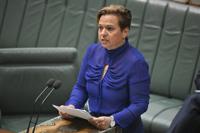TORONTO - A more pessimistic outlook on interest rates and the economy led CIBC to boost how much it set aside for bad loans in its latest quarter, a move echoed by other banks as they prepare for slower growth ahead.
CIBC, the last of the big ║┌┴¤│ď╣¤═° banks to report its third-quarter results, more than tripled its provisions for credit losses from last year to $736 million in the quarter.
The move Thursday came after ║┌┴¤│ď╣¤═° and U.S. central banks responded to stubbornly hot inflation by raising interest rates in the quarter, with another increase potentially coming in September.
The higher rates are leading to more strain on consumers, and are expected to further cool demand for business loans, though the banks emphasize indicators like delinquencies are generally returning to longer-term trends rather than showing concerning spikes.
"Everything we are seeing is pointing towards very strong credit quality, quite a good resilience in the ║┌┴¤│ď╣¤═° consumer books," CIBC chief risk officer Frank Guse told a conference call with investors and financial analysts.
"We see impaired losses normalizing, but we see them normalizing well within our expectations."
Still, CIBC's higher provisions helped push the bank's profits down to $1.43 billion in the quarter ending July 31 compared with $1.67 billion a year ago.
The bank reported total revenue of $5.85 billion, up from $5.57 billion in the same quarter last year.
On an adjusted basis, CIBC says it earned $1.52 per diluted share in its most recent quarter, down from an adjusted profit of $1.85 per diluted share a year earlier.
Analysts on average had expected an adjusted profit of $1.68 per share, according to estimates compiled by financial markets data firm Refinitiv.
Given the headwinds, CIBC joined other banks in saying they were working to contain costs as they expect slowing revenue growth and business activity ahead.
"We've moderated our expense growth," said chief executive Victor Dodig, noting that the bank has flexibility to adjust its investments as needed throughout the economic cycle.
CIBC was one of several banks to already see their head count drop from peak levels. It's full-time employee equivalent count was 48,718, down 1,709 from the fourth quarter of 2022.
RBC also said this quarter it was working to cut its employee numbers after it said it had over-hired by thousands. The bank said it had already cut about one per cent of staff in the quarter, bringing its total to 93,753, and it expects to cut another one to two per cent this year.
Scotiabank's full-time equivalent total dipped by 251 to 91,264 in the quarter, while BMO, TD and ║┌┴¤│ď╣¤═° Bank reported they still hit peak employee numbers in the quarter.
Banks are looking to manage costs given the continued uncertainty ahead after an unprecedented rate cycle.
"We've gone through a cycle that we haven't before in terms of the speed of rate rises. And so I don't think anybody can predict exactly where we go from here," CIBC chief financial officer Hratch Panossian said.
Consumers have been pulling back on discretionary spending in the face of higher costs all around, while the banks have also helped ease the immediate payment shocks on mortgages by stretching out payment schedules.
CIBC, for example, reported that 47 per cent of its ║┌┴¤│ď╣¤═° mortgages had amortization periods of longer than 25 years, up from 43 per cent last year. TD reported 48 per were over 25 years, up from 35 per cent last year, while other banks also reported increases.
Guse said CIBC was reaching out to clients to manage higher rates, with about 8,000 clients increasing their monthly payments and just over 1,000 clients making lump sum payments to remove themselves from negative amortization, and that overall clients are managing well.
"There's no areas of concern that we are seeing so far emerging, because clients are absorbing higher payments," he said.
This report by ║┌┴¤│ď╣¤═° was first published Aug. 31, 2023.
Companies in this story: (TSX:CM)








































